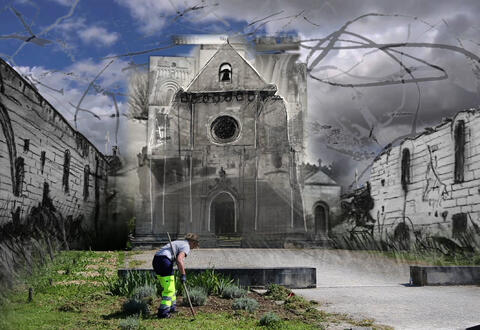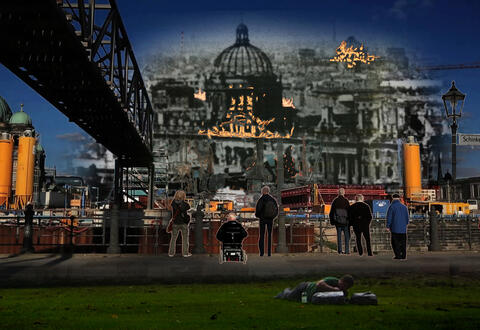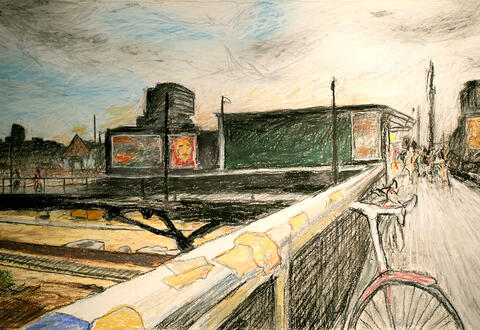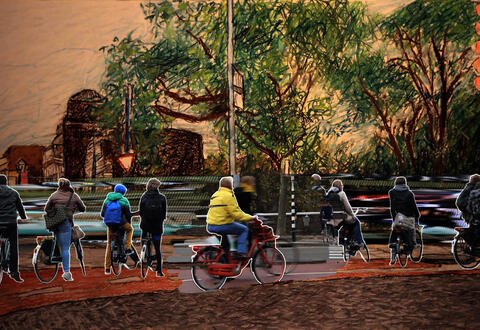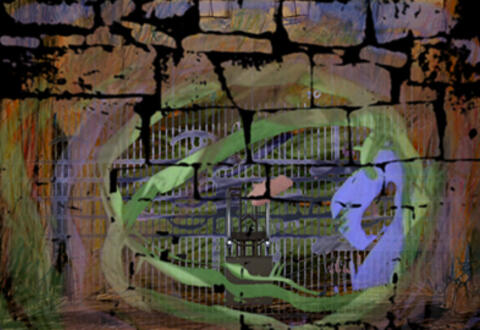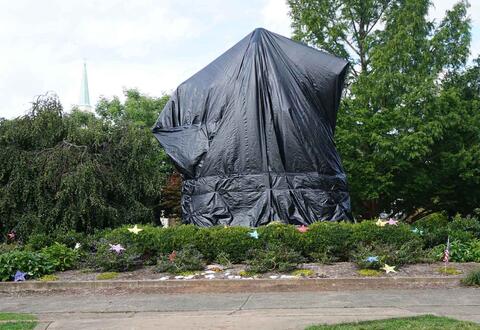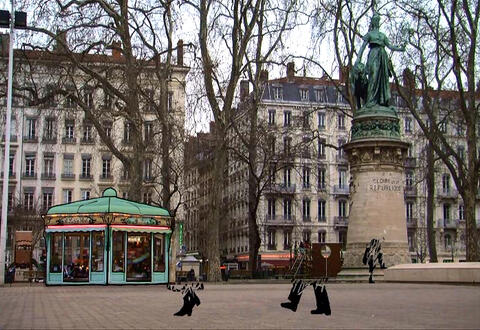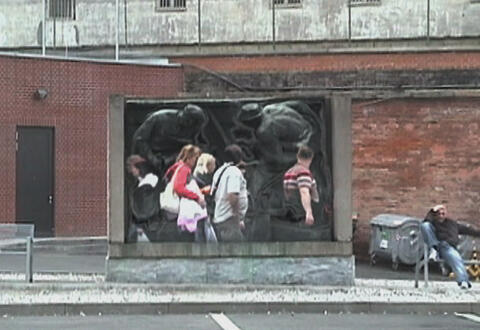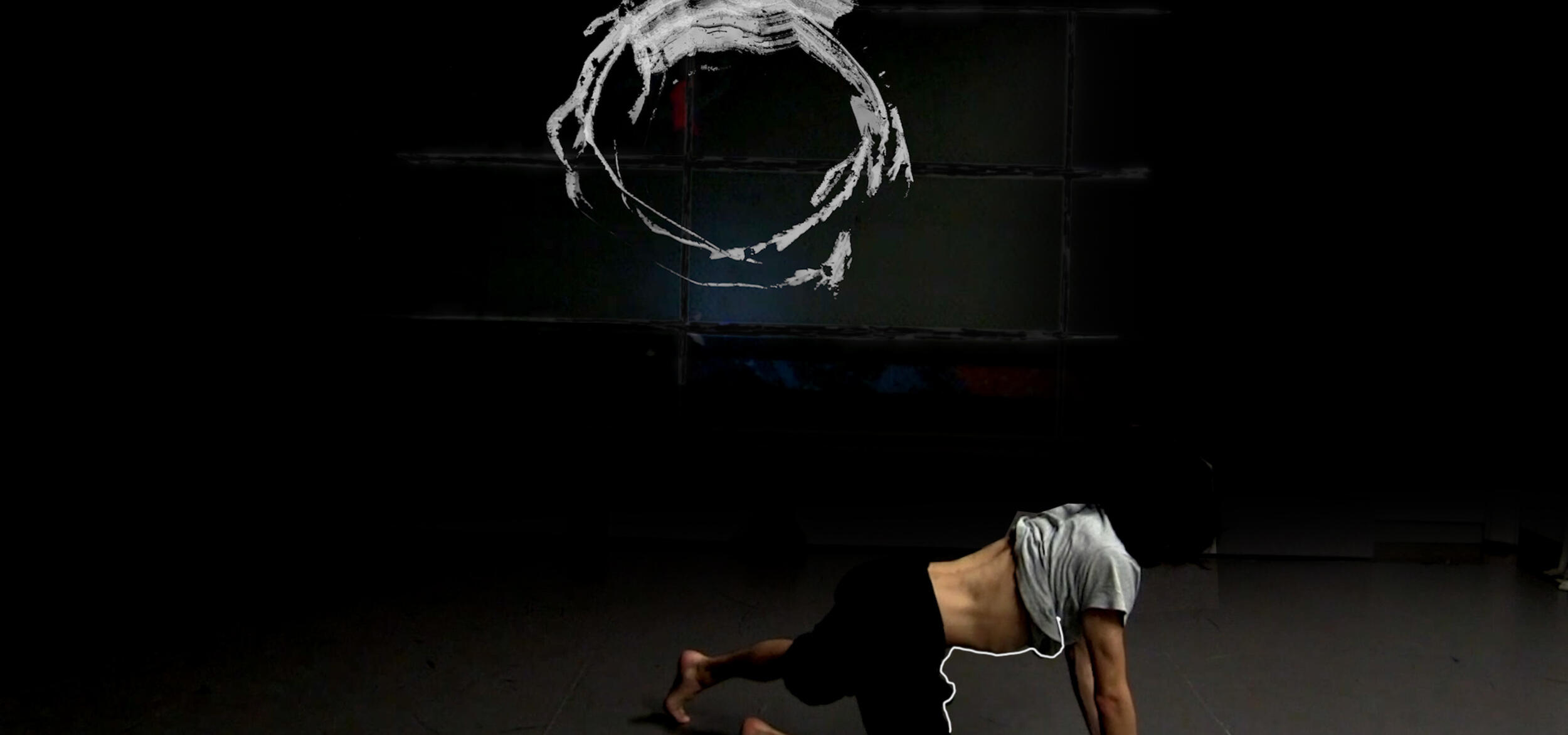
Sources for the film "Mount Fuji Seen from a Moving Train"
Mount Fuji Seen from a Moving Train is a tessitura woven from various threads of my life. It is the intersection of all the personal and artistic currents that make up my life’s experiences.
Mount Fuji Seen from a Moving Train is a tessitura woven from various threads of my life. It is the intersection of all the personal and artistic currents that make up my life’s experiences.
This film was made during a period of illness and the pandemic. It is based on fact. Every aspect of the production (animation, digital treatment, image, and sound editing) took place during the pandemic. And also, during my illness. In September 2019, I was diagnosed with a serious illness that necessitated a sustained treatment for a year from November 2019. My weakened immune system meant I had to go into isolation immediately. In March, the confinement decreed by the authorities due to the pandemic wrapped me in a sort of social cocoon. There was something reassuring in knowing that everyone, the entire world, was suddenly in harmony. This reassurance helped me to accept the reality of a chronic illness but didn’t alleviate the sense of danger installed by the health crisis, on a personal or social level. The risks were twofold: firstly, the personal risk of collapsing during a prolonged period of confinement and, secondly, the diffuse presence of a catastrophic outlook with regards to the future of the pandemic.
Under the circumstances, it seemed absolutely necessary to make a film. It was a question of survival to take advantage of the empty space and time imposed by the pandemic and my illness, and also to find out how my art would be affected by these conditions. This work was my lifeline, it was what kept me positive. It was also a question of fidelity to a life of creating, of finding even more importance and necessity in working on a project even when the possibilities of showing it seemed compromised. I wrote about this in an article called Animation métabolique (published in the March-April 2019 edition of Hors champ, and also included in my book Toucher au cinéma, published by Somme toute, 2021), in which I comment on the simple importance of making art, even if it exists in total secrecy and confinement. In this text I reflected on making art in old age. Suddenly, with the pandemic, conditions arose that threw art’s immanent metabolism into sharp relief and created a significant challenge. No matter: I had to make a film.
It was natural therefore to return to some material I had produced during a two-and-a-half-month creation residency in Japan in 2018-19. This was among my last trips before the illness and pandemic, both of which precluded the possibility of further travel. This paradigm shift was a tough sacrifice for me who, for more than forty years, had travelled several times a year, every year, to nearly all parts of the world. The series Places and Monuments, of which this film is a part, resulted from my nomadism. It seemed right that I should base this film on my impressions of Japan, a country in the antipodes in which, under an ultra-modern surface, lies a profound history of philosophy, spirituality and a way of life that is totally foreign to us. On each of my visits to Japan (2003 and 2018-19), I felt this unsettling strangeness very keenly. I had the impression that these familiar appearances, born of an era of globalisation, were at risk of cracking under our gaze and opening dizzyingly onto a mysterious world, forcing a radical perspective on the occidental world view. It’s a feeling I had already strongly felt at the age of 19, when I began studying anthropology, fascinated by the ‘cultural relativity’ imposed by this science and by the intellectual exercise of ‘deculturalization’ that followed. I have experienced this feeling all my life, but today I understand that detachment from your own culture is no longer very fashionable.
One of the goals of this last trip to Japan was to study Japanese calligraphy. I thought that subjecting myself to the discipline of this thousand-year-old art might influence my approach to scratching on film. At the heart of these two practices is the notion of the sovereign, irreversible, absolute gesture. I soon realized that achieving even a basic mastery of calligraphy was beyond my scope. Two months was a ridiculous length of time for this – it would require years and a much better understanding of the language to achieve any results. Nevertheless, I am convinced that my hard work (two lessons per week and hours of work every morning) had a real effect on my practice of scratching on film, even though I never managed to truly demonstrate it. These exercises had at least improved my awareness and the tension in my scratching. This was the effect I sought when I returned to scratching on film, after having moved away from it for a long time. I firmly wanted to find new approaches, different from my previous ways of working. This led to my embarking on an ambitious project in which scratching on film would play a predominant and unusual role.
Several years ago in Montréal, I met choreographer Teita Iwabushi. I enjoyed the extreme and intense slowness of his dance routines and the precision of his gestures. We promised to collaborate one day. This trip gave us that opportunity. I attended rehearsals of a show that he was working on and we did several improvisation workshops together, which I filmed. In the context of Japanese immersion, I was looking for connections between learning calligraphy, my animation practice, and dance. This network of connections was amplified by the fact that Teita’s dance adheres to the Butoh tradition, implying a certain relationship with the extreme experience of the atomic bombing of Japan at Nagasaki and Hiroshima at the end of the Second World War. I saw a natural extension of the introduction to calligraphy in this collaboration, as if it were part of the same quest.
In December 2019, thanks to a collaboration with the animation school of the Tokyo University of the Arts, I presented a Tokyo version of Scratch with live scratching on film. This project was therefore the focal point of my return to scratching on film. I was accompanied by toy instruments programmed by Yuichi Matsumoto. This performance followed several others that were presented in Montréal and Paris, which also widely anticipated what I was looking for in calligraphy. Two 16mm projectors showed two desynchronized loops of differing lengths. This device stemmed from my interest in the correlation between distinct loops as a way of generating more complex configurations, ‘always rebeginning’ like Valéry’s sea. This performance was also filmed.
During this last visit to Japan, I made numerous recordings in public places. This was due to the language barrier. Not understanding the Japanese language led me to an interest in the simple visceral charge that is inherent in language. Slowly but surely, the project began to transpose this charge, as well as the communicative urge that results from it, onto scratched on film animation (itself a cut-off point of cinema, close to an explosion). A film materialized, one of whose threads was this situation of being submerged in a linguistic flood that was impenetrable but which we knew had meaning. It had the effect of transmitting the experience of communication as a pure state, expressed before meaning. We simply hear the sound of humans talking, nothing more. Simply put: they are talking amongst themselves.
After two months in Tokyo, where I had been absorbed in my residency programme, my spouse and I travelled to other regions of Japan, where I filmed more footage in the style of Places and Monuments, such as at sites in Nagasaki that commemorate the atomic bombing of 1945, and on the island of Yakoshima, whose primary forest is a UNESCO World Heritage site. For this trip, we travelled by train and passed Mount Fuji, where I made a recording that would become the central point of the film.
I first travelled to Japan in 2003, during a memorable tour with my musician-improvisor Bob Ostertag. It was during this tour, at the University of Chukio in Toyota, that the first sign of what would, 10 years later, become Places and Monuments was created, under the title of Portrait of Buddha. Throughout our journey, we were constantly accompanied by the tour’s organizer. He served as an interpreter and protected us from the linguistic barrier to communication that surrounded us. Towards the end of the trip, I wanted to spend a day wandering around Tokyo on my own. This was how I happened upon the Senso-ji temple. There was a funfair around the perimeter of the temple, with lots of activities, outdoor shows, restaurants, market stalls, etc. I had my mini DV camera with me and began to film my walk through the area, guided by my gaze. This footage has become very valuable to me as it was my only solitary escapade in this world which, at the start, had felt impenetrable. I still remember it well. In 2009, the Places and Monuments project formally began with the first in the series, Praha-Florenc. I initially thought I would create the third part using footage shot in Senso-ji in 2003. After several false starts, the film was stalled and the number three in the Places and Monuments series has remained vacant for 10 years. When Mount Fuji Seen from a Moving Train began to take shape, it immediately became clear that it would include the material shot in 2003. Suddenly Places and Monuments 3 became the 11th in the series, hence the designation Places and Monuments 3/11.
This numbering would have merely been a playful way of allowing me to fill the void of the elusive number three if, shortly afterwards, I hadn’t serendipitously learned that in Japan the expression ‘3/11’ signifies the chain of catastrophic events (the earthquake, tsunami, and nuclear accident at Fukushima) that hit the country in March 2011. Through a numerical coincidence, my project suddenly became associated with this history. In March 2011, I had spent many days riveted in front of the television, watching the catastrophe unfold in horror. This coincidence was the departure point for the film. It allowed me to combine the dance sequence, the Nagasaki footage, and references to Fukushima and the seismic and volcanic threat.
I have long been fascinated with earthquakes and volcanos. In Kagoshima, in our hotel room on the 13th floor, we experienced an earthquake that measured four on the Richter scale. Unfortunately, I did not have the presence of mind to film the blinds as they clacked against the window in time with the swaying tower. It was an intense and slightly terrifying moment. My first visit to San Francisco was a week after the devastating earthquake of 1991. In Kagoshima, we were facing the enormous mass of the Sakurajima volcano which dominated the city from the other side of the bay. It’s an active volcano and considered to be dangerous. Aboard the ferry, we had admired the elegant silhouette of the Kamondake volcano on the south side of Kyushu and, from our ryokan on Yakushima Island, we were able to see, on the horizon, the smoking volcano on Kushinoerabu-shima island. We also saw the Hakone volcano, which is close to Tokyo and is also active. In the past, I have made many visits to Catania, at the foot of Etna, the king of volcanos. Another time, I found myself in Naples, to meditate before Mount Vesuvius, and have seen Stromboli from above, in an airplane, which called to mind the films of Rossellini. In Costa Rica, the state of the roads meant we were unable to reach Arenal and had to climb in the rain and fog to get to the crater of Mount Poâs, which erupts every 40 years and whose sulfuric emanations we could smell, though we didn’t see much. At dusk, on the terrasse of a hotel in Puebla, Mexico, we admired the luminescent flashes on the summit of Popocatépetl. During a sort of pilgrimage to Cuernavaca, we followed the trail of the cult novel Under the Volcano. I have also seen, from afar but with emotion, Mount St Helens in Washington state in the US, which erupted in 1980. In Martinique, the Pelée mountain and the Saint-Pierre ruins. I run after volcanos like others chase tornados. Japan is home to the densest and most intense concentration of seismic activity in the world. There, we have no choice but to accept the important and unsettling fact that the earth has intense, usually invisible, underground activity, and orifices that allow it to be violently projected outside, reminding us that we are impotent in the face of such telluric power. In light of this, it is not surprising that Mount Fuji, with its imposing presence, is the symbol of Japan. Nor is it surprising that the onsens, hot springs from thermal volcanic sources, are the object of almost ritualized attention, perhaps as a way of mastering the symbolic relationship with the threatening forces from the earth’s depths. In the same spirit, in Kagoshima, the traditional Sengan-en garden is conceived according to the principal of ‘borrowed lands’, which involves integrating the surrounding wild landscapes into the garden. In this case, the Sakurajima volcano is omnipresent and, in its indomitable majesty, it plays a central role in the meticulous arrangement of the garden. Is this also a way of taming telluric forces? For me, we were only one step away from connecting seismic dangers and nuclear threats.
Filming Mount Fuji from a train corresponded to my old fantasy of doing as Robert Breer did for his film Fuji (1974). In the early 1960s, this experimental American filmmaker had been one of my heroes alongside Norman McLaren, Len Lye, Robert Lapoujade, Stanley Brakhage and Stan Vanderbeek. And Fuji, in particular, seemed to me retrospectively to be similar in spirit to Places and Monuments. This film is based on a simple filming of Mount Fuji from a moving train amplifying the impact with a radical form of animation. In 2003, I had seen Mount Fuji three times at sunset from an airplane, a memorable spectacle. But the few times I had passed it aboard a train, in 2003 and 2018, the volcano had been invisible, enveloped in clouds. I hadn’t been able to film it. On the 19 January 2019, on my 75th birthday, emerging from a tunnel, Mount Fuji appeared, majestical, clear against a sky-blue background, like a birthday gift. My camera at the ready, I was able to shoot Mount Fuji from a train, from the moment it emerged until it disappeared behind other mountains. I remember holding the camera, incredulous, in a state of extasy before the scene.
It could be said that the material I brought back from Japan for this film cannot simply be reduced to a stock of images, a catalogue of plans and some sound clips. In every aspect, it is also the product of life’s themes, the artistic and existential experiences that extend the furrows that have already marked my life and work for a long time. They demand to be extended in this film project which, from this perspective is not merely a film about Japan as such, but a point of intersection and synthesis. In this sense, it responds to a profound necessity.
And so, this new film pursues and transforms the adventure of the Places and Monuments project begun more than 10 years ago, whose distant and modest origin took place in Japan in 2003. This project was first organized around a precise filming protocol: I set the camera up in front of a monument in a public place, positioned myself in plain sight behind it, and recorded, within a still frame, the daily comings and goings of the area for long enough that something significant should take place that questions the passage of time, memory, and forgetting. These images then undergo a combination of digital interventions, and animations are added to bring out all possible meanings. These time capsules should be geographically distributed so that the ensemble creates an image of the world from these small autonomous blocks centred around well-demarcated areas. Over time, the project became more complex. I was interested in an entire city (Berlin – The Passage of Time), a whole region (the Charente Maritime for Bazin’s Film) and, finally, a country (Japan). I expanded the conceptual frame, while it remained a reference, and the films in the series became increasingly comprised of multiple elements from diverse sources. The resulting constructions were much more complex. In Mount Fuji Seen from a Moving Train, only the Nagasaki shoots (at the Peace Park and the monument situated at the point of impact of the bomb) followed the above-mentioned protocol to the letter. But it is mainly the use of sound recordings and the predominant place that scratched film animation holds that makes this new film stand out from earlier films in the series. It is also the only case in which more animation is used than recorded footage. In the preceding films, it was the contrary. The unique presence of scratching on film is an interrogation in its own right. There were some hints of this in Bazin’s Film, but here it is the dominant element.
Scratching on film has been my preferred technique, in successive waves, since my discovery, in the early 1960s, of the work of Norman McLaren and Len Lye. This lasted until the early 2000s, when I introduced digital animation in my live performances, with the unintended consequence that I abandoned scratching – irrevocably, I believed. 15 years later, repressed instincts rose to the surface and scratching on film has slowly but surely returned to my performances to the extent that I have been forced to seriously reconsider its place in my practice. An organized programme to restore my technical skills and renew the aesthetic aspect followed, from short exercises to the film But One Bird Sang Not (2018), via various stages, films, performances, and video installations. But One Bird Sang Not seemed to me to be the happy outcome of this effort. I had found a new form of discursiveness with this technique. For this film, I synchronized the animation very precisely, frame by frame, with music by Malcolm Goldstein. I had always refused to take such an approach. It was Malcom’s unique music and his natural affinity with the particularly textured lengths of scratching on film that led me to such an exercise. I wanted to do the same detailed work of synchronization with my recordings made in public places in Japan. I was hoping that this would open up another way of linking reality and animation and that the documentary scope of my project would take on another dimension. But I came up against unexpected difficulties that forced a return to certain older practices.
It turned out to be a lot more difficult to synchronize frame-by-frame with a recording made in a public place than with a piece of music, as the sonic ‘events’ had been fatally drowned out by the ambient noise and were often difficult to identify. Rather, these recordings are like a kind of modulated magma, static and looped. There is rarely a dramatic vector in the noise of a crowd. I wasn’t sure of the relevance, in this case, of frame-by-frame synchronization. This brought me back to a line of research dating back to my film Songs and Dances of the Inanimate World – the Subway (1984) and even further back to OpHop (1965). In Subway, I set myself the challenge of animating the intensity of a motionless gaze. Excluding the simple recourse to the fixed nature of a still frame or the calm vibration produced by a short cycle of several images, I imagined a formula that brought order and disorder together through a sort of evolving cycle: with each repetition of a short loop, a new image was added at the end of the cycle, so that the oldest one was removed from the start of the cycle. The loop remained the same length, but the images within it gradually changed. This process could be set against the sub-cycles inscribed in the initial loop, to generate a variety of figures. I quickly forgot the problem of ‘animating a gaze’ in favour of the rhythmic potential of these figures. In 2001, this system of shifting cycles formed the basis of my first performance software. This idea was then developed in line with the possibilities of computational capacity: the permutation of the order of the images, the change of direction of the cycles, the addition of colors and, above all, the superimposition of several layers of differing lengths in order to use the thread of overlaps to institute the animated flow. This process was the principal of my video installations (two, three or four unequal channels) that, through the use of intervals, could have a complete cycle of up to several hundred years before returning to the initial state. With the installation Scratch – Polyphony of Flickers, this formal construction converged with the return to scratching on film in my work, setting the scene for the animation But One Bird Sang Not and then Mount Fuji Seen from a Moving Train.
The particular temporality of the rumbling noise of crowds and public places therefore brought back my old unsolvable problem of animating a still gaze. The same type of elusive temporality was involved – slow, non-linear, contradictory. This led me to approach the visualization of sonic atmospheres using short segments of scratched animation that serve as basic cyclical modules created from superimpositions of temporal flows that unfold according to a slow combinatorial evolution. This basic outline is, moreover, altered by subsequent interventions (the suppression or changing order of images, the elongation or reduction of ‘black spaces’, the addition of accents) to adjust it to the events that punctuate the soundtrack. This has been made possible by the convergence between scratching on film and digital technology. My return to the former is therefore indissociable from the latter. Ironically, the technical developments that had initially led scratching to be removed from my practice, serve today to consolidate its return and heighten its potency.
In OpHop (1966), I had proceeded in a similar fashion with a block of 24 animation images, which I had ordered many copies of in the lab. I then used them to change the order of the sub-groups included in the initial loop. Editing in 35mm was obviously arduous and limited work, compared to what is possible now in digital editing. Nevertheless, the principal remains the same: manipulate the possible combinations of small groups of initial images. What is new with digital tools, besides the complexity and variety of possible manipulations, is that the possibilities of polyphonic constructions are now almost infinite. This was where Bach joined the rumbling of the crowd and sparked my dream of making The Art of Fugue from the sounds of public places. It isn’t about creating a direct interpretation in the image but rather, through a roundabout route, creating a mode of temporality that approaches this rumbling, without being conflated with it. Or creating a common ‘meta-temporality’ in which the two irredeemably heterogenous temporal elements, visual and sonic, combine in a play of crossovers and discord. In the event, my experience is that we perceive the flow of images according to the structure of the sound that accompanies them. Even more so with scratching on film, in which the images’ instability makes each photogram a possible point of synchronicity, which lends great plasticity when it is put together with the music. Is this hierarchical coordination between the eye and the ear the consequence of a neurological condition in humans? I believe so. The ear dominates and rules the rhythm of the perception of temporal flow. On the other hand, in such a construction, the perception of sound is also transformed, as the magma of the noise of the crowd differentiates itself. We come to understand, through our attraction to the image, what we couldn’t otherwise perceive. The sound is reflected in the image and, in becoming ‘visible’, is emphasised.
I would like to add that my collaboration with Teita Iwabushi is the result of a sustained interest in dance as an artform. This is another of my life’s threads to have found a place in this film. Early on, I created animated set designs for a number of dance routines: Timber (1986) by Ginette Laurin; The Technology of Tears (1987) by Rosalind Newman; and Braises blanches (1990) and Elles (2002) by Louise Bédard. I have also taken part in workshops and improvised shows with many dancers. A number of films have resulted from these shows: La lettre d’amour (1988), Variations on Two Photographs by Tina Modotti (2004) and The Technology of Tears (2005). For a long time, dance has been at the centre of my reflections on the nature of animation, the role of the body in dance and animation, and the difference between movement danced and movement animated. It was therefore only natural that, in Japan, I should want to collaborate with a Japanese dancer.
The film was constructed like a tangle of threads that became interwoven and spread throughout, from beginning to end, sometimes in the foreground and sometimes in the background. They are all potentially present, together, at any point. There is the thread of dance, as mentioned above, which begins with the mime on the fairground stage at Senso-ji and follows with Teita’s dance, which almost becomes a narrative thread, passing from the rehearsal studio in Yokohama to the Peace Park, in the area where the bomb hit, and finally to the devastated sites at Nagasaki and Fukushima. The quasi-narrative thread is a fabrication of the film and not an intention of the dance itself. When it was improvised, it developed freely. The theme of the train runs through from the beginning to the end and takes different forms. The Shinkansen features at the beginning and the end, and between these the sounds of all sorts of other trains and metros are evoked. The theme of Mount Fuji is announced in the title and finally shown in the last shot of the film. In between, we see engravings from Hokusai’s series, 36 Views of Mount Fuji (1833). I can list other elements: the singer and the fairground at the Senso-ji temple, the injections of color in the animation, the vibrations of the screen, the zen circle scratched on film… and to this is added, on the soundtrack and musical score, the bells and drums of Buddhist temples, the sound of Geiger counters, electronic drones, John Barrett’s piano and vibraphone music, and the violin and drum improvisations of Malcolm Goldstein and John Heward. The ambient noise of public places and the rumblings of the crowd are almost always present, mixed in and alternating with the other themes.
This film is therefore a quasi-musical composition, based on the recurrence of visual and sonic themes, as much on a macroscopic as microscopic level (for example the network of interferences that emerged in the scratched-on-film animation and the micro-reconstruction of certain soundtracks). Therefore, on one hand there is this formal and circular construction that constitutes the fundamental movement of the film and induces a contemplative state. But the film is also made up of well-defined parts, centred around actual places. There is also a movement of the ensemble that leads to a climax (the evocation of the nuclear catastrophes at Nagasaki and Fukushima), and the final resolution (to finally see Mount Fuji from a moving train), which returns to the question posed at the beginning of the film (what is there to say or show of Mount Fuji when it is invisible, lost in the clouds?). On this level, there is a classic narrative structure, even if it is presented in an abstract form and we aren’t told a story as such. But it is adapted and counterbalanced by the other flow, which is contemplative, and which plays the role of a sort of continuous bass. The overall construction of the film is made up of overlaps and attractions between these two aspects.
I call it a ‘quasi-musical composition’. Throughout the making of this film, I constantly had an idea in mind regarding a process inspired by musical composition. I repeat that I don’t believe, generally, in fusing music and images as counterparts. I think the expression ‘visual music’, which enjoys a certain popularity in abstract animation circles, is misleading. I consider the temporality of music (or any sound construction) to be ontologically different to the temporality of images. They are not inscribed in the same way in the passage of time and represent different modes of duration. How therefore can this be reconciled with the idea of a ‘quasi-musical composition’? I would say that this composition is quasi-musical in as far as it is situated at the level of the meta-temporality I mentioned earlier. It is about composing sonic and visual elements by putting them on the same plane and letting their irreducible difference play out. These ‘elements’, with the double perspective that characterizes them, can be called ‘themes’, on the most abstract level, and so they can be seen as analogous with musical composition.
What were the effects of my illness on the emergence of such an approach? Chemotherapy has violent effects on the body and, in many respects, it alters normal organic functioning and creates a sort of alternative unwell body. Further, in the moral context (in that all at once death ceases to reside on a blurred horizon and becomes a concrete deadline, and pain becomes normal), the diagnosis and the beginning of treatment constitutes a true devastation. But despite everything, the shock elicits a surprising acuity, a form of ‘life’ that isn’t all negative. An initial example is the society of ill people, the conviviality and fraternity between them and between patients and carers. A new way of life that must be adapted to, which permits a transformed look at the fundaments of human existence. The ‘present moment’ takes on a relevance and an inconceivable intensity in other aspects of life. This prominence of the ‘present’ probably explains an alteration in my aural acuity that was translated into a transformation of my perception of music. In my mind, the musical flow seems to transpose directly, without the effort of analysis, into architectures spread out in space. A sort of spontaneous visualisation of musical structures, on a level of abstraction that renders them applicable to all materials. There is no doubt to me that this contemplative faculty that came from the illness had a decisive effect on what I call the quasi-musical composition of this film. I could say comparable things about poetry, in which the images place themselves in an almost Mallarmé-esque mental space.
And so, in counterbalance to the analogy with musical composition, I had the idea of an analogy with writing poetry, in which it is about letting the sonic and visual elements move freely in their own semantic networks and be attentive to the connections of unexpected meanings. From this perspective, the sonic and visual ‘elements’ are like monads, closed entities that communicate with each other according to their own energetic potential, as if by an electric shock. This is another instance of correlation in which meaning appears like lightning that shines according to the bends of the formal construction. From this point of view, it is the process of the film’s genesis that rules the appearance of meaning and not the meaning that directs the film. Perhaps only cinema permits this, through this balancing of different sensory zones, between different registers of meaning and formal construction, of moving forward in quite hazardous zones. Between the impression of writing about poetry and that of making music: this is the creative state in which I found myself during the making of this film. This is how this feature-length film was made. And it will remain my workspace.
The original French version of this text was first published by Hors champ in May-June, 2021.
Translation: Sarah Knight






